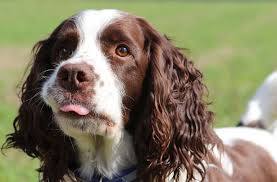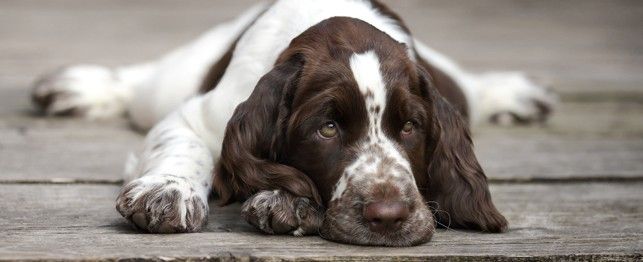The English Springer Spaniel is a breed of gun dog in the Spaniel family traditionally used for flushing and retrieving game. It is an affectionate, excitable breed with a typical lifespan of twelve to fourteen years. They are very similar to the Welsh Springer Spaniel and are descended from the Norfolk or Shropshire Spaniels of the mid-19th century; the breed has diverged into separate show and working lines. The breed suffers from average health complaints. The show-bred version of the breed has been linked to “rage syndrome”, although the disorder is very rare. It is closely related to the Welsh Springer Spaniel and very closely to the English Cocker Spaniel; less than a century ago, springers and cockers would come from the same litter. The smaller “cockers” hunted woodcock while the larger littermates were used to flush, or “spring”, game. In 1902, The Kennel Club recognized the English Springer Spaniel as a distinct breed. They are used as sniffer dogs on a widespread basis. The term Springer comes from the historic hunting role, where the dog would flush (spring) birds into the air.
DESCRIPTION
The English Springer Spaniel is a medium-sized compact dog. Its coat is moderately long with feathering on the legs and tail. It is a well proportioned, balanced dog with a gentle expression and a friendly wagging tail. This breed represents perhaps the greatest divergence between working and show lines of any breed of dog. A field-bred dog and a show-bred dog appear to be different breeds but are registered together. The gene pools are almost completely segregated and have been for at least 70 years. A field-bred dog would not be competitive in a modern dog show, while a show dog would not have the speed or stamina to succeed in a field trial.

The English Springer Spaniel field-bred dogs tend to have shorter, coarser coats than show-bred dogs. The ears are less pendulous. Field-bred dogs are wiry and have more of a feral look than those bred for showing. The tail of the field-bred dog may be docked a few inches in comparison to the show dog. Field-bred dogs are selected for their sense of smell, hunting ability, and response to training rather than appearance.
Show dogs have longer fur and more pendant ears, dewlaps, and dangling flews. The tail is docked to a short stub in those countries that permit docking. They are generally more thickly boned and heavier than field-bred springers.
The English Springer Spaniel is similar to the English Cocker Spaniel and at first glance, the only major difference is the latter’s smaller size. However English Springers also tend to have shorter, and higher-set ears than English Cockers. Springers also tend to have a longer muzzle; their eyes are not as prominent, and the coat is less abundant. The major differences between the Welsh Springer and the English Springer are that the Welsh have more limited colors and tend to be slightly smaller.
COAT AND COLORS
Field-bred dogs tend to have shorter, coarser coats than the longer furred show-bred dogs. They normally only shed in summer and spring months but shed occasionally in the autumn. The coat comes in black or liver (dark brown) with white markings or predominantly white with black or liver markings; Tricolour: black and white or liver and white with tan markings, usually found on eyebrows, cheeks, inside of ears and under the tail. Any white portion of the coat may be flecked with ticking.
SIZES
Males in the show dog line are typically approximately 19 to 21 inches (48 to 53 cm) at the withers and weigh 40 to 60 lb (18 to 27 kg). According to the UK Breed Standard, the English Springer Spaniel should be 20 inches (51 cm) at the withers. The females should be 18 to 20 inches (46 to 51 cm) and usually 35 to 55 lb (16 to 25 kg). Working types can be lighter in weight and finer in the bone.
TEMPERAMENT
The typical Spaniel is friendly, eager to please, quick to learn, and willing to obey. In the right circumstances, it can be an affectionate and easy-going family dog. Its alertness and attentiveness make it a good hunting companion. A typical Springer Spaniel will often choose one person in the family to be most loyal to and stick with that person as much as possible, they are often referred to as a “velcro dog”. The English Springer Spaniel ranks 13th in Stanley Coren’s The Intelligence of Dogs and is considered an excellent working dog. It has exceptional stamina and needs moderate amounts of activity, to focus its mind and to provide exercise, although this is different for each dog. Its long-legged build makes it among the fastest of the spaniels.
It is a sociable breed that enjoys the company of children and handles the company of other pets well. The hunting breed may not get along well with cats, however. If left alone for too long, they can become destructive and mischievous through boredom.
HISTORY
The English physician John Caius described the spaniel in his book the Treatise of Englishe Dogs published in 1576. His book was the first work to describe the various British breeds by function. By 1801, Sydenham Edwards explained in the Cynographia Britannica that the land spaniel should be split into two kinds, the Springing, Hawking Spaniel, or Starter; and the Cocking or Cocker Spaniel.
At this point, both cocker spaniels and springer spaniels were born in the same litters. The purpose of the breed was to serve as a hunting dog. The smaller cockers were used to hunt woodcock, while their larger littermates, the springer spaniels, would “spring”—or flush—the gamebird into the air where a trained falcon or hawk would bring it to the handler.
Many spaniel breeds were developed during the 19th century, and often named after the counties in which they were developed, or after their owners, who were usually nobility. Two strains of larger land spaniel were predominant and were said to have been of “true springer type.” These were the Norfolk and the Shropshire spaniels, and by the 1850s, these were shown under the breed name of Norfolk spaniel.
In January 1899, the Spaniel Club of England and the Sporting Spaniel Society held their trials together for the first time. Three years later, in 1902, a combination of the physical standard from the Spaniel Club of England and the ability standard from the Sporting Spaniel Society led to the English Springer Spaniel breed being officially recognized by the English Kennel Club. The American Kennel Club followed in 1910. In 1914, the first English Field Champion was crowned, FTC Rivington Sam, whose dam was a registered cocker spaniel, Rivington Riband. Sam has considered one of the foundations sires for modern field lines.


Leave a Comment